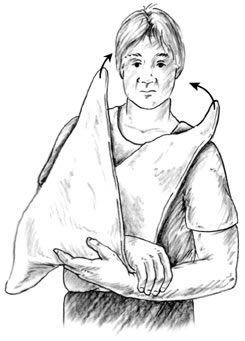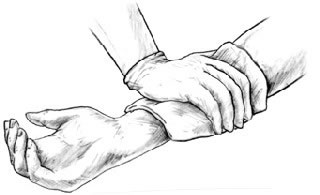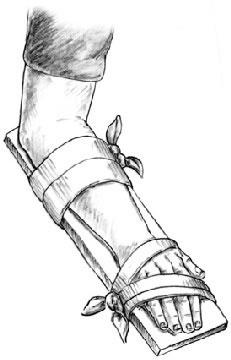Photos

FIRST AID Advice - Arm Injury - How to Put on a Sling
To put on a sling you first need to have a triangle-shaped bandage. Many first aid kits have a triangle bandage.
- Find the two ends of the triangle that are farthest apart. These are the ends that you will tie around the neck.
- Lay the arm down the middle of the triangle.
- Take the two ends of the triangle that are farthest apart and tie them behind the neck (a square knot is best, but any knot will do).
- Make sure the wrist is at a level higher than the heart.
Source: Self Care Decisions, LLC
Used with Permission from Schmitt Pediatric Guidelines LLC.

FIRST AID Advice - Bleeding Wound of the Arm
- Apply direct pressure to the entire wound with a sterile gauze dressing or a clean cloth. Once the bleeding has stopped, cover with an adhesive bandage or gauze.
Source: Self Care Decisions, LLC
Used with Permission from Schmitt Pediatric Guidelines LLC.

FIRST AID Advice - Splint for Wrist Fracture or Dislocation
- Keep the hand and wrist from moving by placing them on a rigid splint (see drawing).
- Tie several cloth strips around hand/wrist to keep the splint in place. You can use a roll of gauze or tape instead of cloth strips.
Notes:
- You can make a splint from: a wooden board, magazine folded in half, folded-up newspaper, cardboard, or a pillow.
- If you have no splinting materials, then support the injured arm by resting it on a pillow or folded up blanket.
- After putting on the splint, apply a cold pack or an ice pack (wrapped in a towel) to the area.
Source: Self Care Decisions, LLC
Used with Permission from Schmitt Pediatric Guidelines LLC.